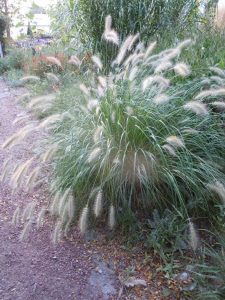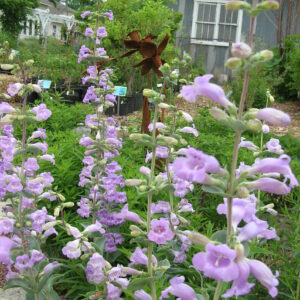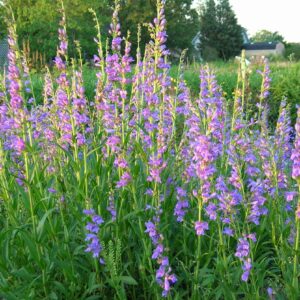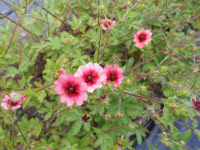Drought, Xeric & Dry Soil Plants
Showing 89–96 of 132 results
-
Pennisetum orientale Oriental fountain grass Z 5-10
Showy, white to pinkish inflorescences summer thru fall.
Showy, white to pinkish inflorescences summer thru fall. Richard Darke, grass guru, describes this as “One of the most striking hardy fountain grasses. Low growing, compact and exceptionally floriferous … Blooms over an unusually long period from late June through October”
Size: 2' x 2'
Care: sun in well-drained soil or moist well-drained soil. Deer resistant and drought tolerant.
Native: central & SW Asia
Awards: Elisabeth Carey Miller Botanical Garden Great Plant PicksThe plant is named for its soft inflorescences; Latin penna and seta mean feather-bristle. This species collected before 1821.
-
Penstemon grandiflorus Large beard tongue Z 3-9 short-lived perennial that reseeds
Large pink to lavender trumpets along the 3’ stem in early summer
OUT OF STOCK
Large pink to lavender trumpets along the 3’ stem in early summer
Size: 3’ x 10”
Care: full sun in well-drained soil
Native: IL to N. Dakota, south to TX, Wisconsin
Wildlife Value: attracts Baltimore butterflyDiscovered by Thomas Nuttall, (1786-1859) who searched entire No. American continent, describing this Penstemon as “splendid and beautiful,” on his trip up the Missouri River in 1811. Cured chest pains and stomach aches for the Dakota and chills and fever for the Pawnee. Sioux made decoctions of this to remedy chills and fever and chest pain.
-
Penstemon strictus Rocky Mountain penstemon Z 3-8
Spikes of deep purplish-red bells in summer
OUT OF STOCK
Spikes of deep purplish-red bells in summer.
Size: 30" x 24"
Care: Full sun in well-drained soil. Drought tolerant
Native: Wyoming to Arizona
Wildlife Value: feeds bees, hummingbirds and butterfliesPenstemon is named for its five stamens, penta meaning five and stemon meaning stamen in Greek. Strictus means “erect.” This species collected by explorer, military officer and politician John C Fremont (1813-1890) and described in 1846.
-
Petrophytum caespitosum Mat rock Spiraea Z 4-9
Tight cushions bearing white spikes August-September.
OUT OF STOCK
Tight cushions bearing white spikes August-September. Its roots penetrate rock crevices and cracks
Size: 4” x 4-6’
Care: sun to part shade in well-drained soil. Drought tolerant. Do not allow leaf litter to cover it.
Native: Sierras to Rocky MountainsCollected by premier plant hunter Thomas Nuttall 1834-1837 on his exploration across the continent to the Pacific “on high shelving rocks in the Rocky Mountains, towards the sources of the Platte.”
-
Polemonium brandegeei Brandegee’ Jacobs-ladder, Yellow sky pilot Z 4-8
Hanging, tubular yellow, sometimes white blooms over frilly foliage, May-July
OUT OF STOCK
Hanging, tubular yellow, sometimes white blooms over frilly foliage, May-July
Size: 8” x 10”
Care: sun to part shade in very well-drained soil
Native: CO, NM, SD, UT, WY
Wildlife Value: attracts bees, butterflies & mothsCollected by Townshend Stith Brandegee in the ‘Valley of the Rio Grande, on the Los Pinos Trail’ c. 1870. Brandegee then sent it to Harvard botanist Asa Gray who identified and named it to honor its collector.
-
Polygonatum multiflorum Solomon’s seal Z 4-10
Dainty white flowers dangle from arching stems
Gracefully arching stems without branches with leaflets on both sides of the stem, nearly parallel and dangling ivory bells. Flowering in spring, each flower turns into a glaucous blue berry. The leaves “make a fine mass of elegant foliage,” Sanders, 1913.
Size: 5' x 10"
Care: shade in fertile, humusy, well-drained soil. Good dry shade plant, drought tolerant.
Native: Europe and Asia
Wildlife Value: Birds eat the fruit. Pollen and nectar feed a number of bee species.Greek physician Dioscorides named Polygonatum in the 1st century, which means “many jointed” referring to scars on the rhizome. Medieval herbalists opined that Biblical figure Solomon put scars on the rhizome to demonstrate the plant’s curative powers. P. multiflorum cultivated in English gardens by 1450. In 1596 English herbalist Gerard (1545-1612) endorsed its use to repair broken bones – mix the pulverized root and drink it with ale to “gleweth together the bones in very short space.” He also claimed fresh stamped root would cure cuts and bruises for “women’s willfulness in stumbling on their hasty husband’s fists.” According to Culpepper, Italian wives “much used” this remedy.
-
Potentilla atrosanguinea Himalayan cinquefoil Z 5-8
Open pink cups in June-July
Summer to autumn, ruby to pumpkin-colored blossoms shaped like a single petal rose, top pleated silvery foliage.
Size: 18-24" x 24"
Care: Sun well-drained soil
Native: HimalayasPotentilla is Latin meaning powerful referring to medicinal properties. Potentillas used by dentists in the 16th century to reduce pain according to Gerard, English herbalist. Per Culpepper, 17th century English herbalist, potentilla is to be used if Jupiter is ascending and the moon is “applying to him.” Atrosanguinea 1st collected in its native Nepal in 1822. American garden cultivation of this species since mid-1800’s
-
Potentilla rupestris syn. Drymocallis rupestris Rock cinquefoil, Siberian tea Z 5-8
White, single rose-like saucer flowers with prominent yellow stamens in early summer.
White, single rose-like saucer flowers with prominent yellow stamens in early summer.
Size: 10-20" x 12"
Care: sun to part shade in well-drained to moist well-drained soil
Native: Europe, Asia & mountains of western No. AmericaPotentilla is Latin meaning “powerful” referring to medicinal properties. Rupestris means “rock loving.” This species 1st identified in literature in 1650. Russians used the leaves to brew tea.







